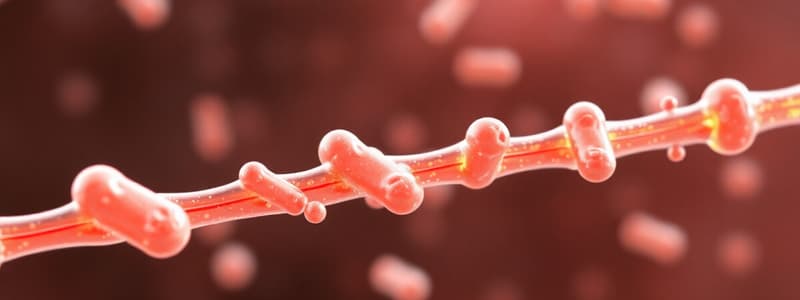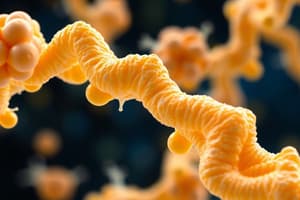Podcast
Questions and Answers
What characterizes the distribution of a drug that has central and peripheral compartments?
What characterizes the distribution of a drug that has central and peripheral compartments?
- Drugs can only move from the central to the peripheral compartment.
- Equilibrium is established quickly between plasma and tissue.
- Elimination occurs from the peripheral compartment.
- Drugs can move to and from the peripheral compartment back to the central compartment. (correct)
Which statement accurately describes first order elimination kinetics?
Which statement accurately describes first order elimination kinetics?
- The rate of decrease in drug concentration is constant regardless of the amount in the body.
- A constant fraction of the drug is eliminated at any given time. (correct)
- A constant amount of drug is eliminated independent of dose.
- The elimination rate is dependent on the dose administered.
In a semi-log plot for first order kinetics, what does the graphical representation look like?
In a semi-log plot for first order kinetics, what does the graphical representation look like?
- An upward sloping line.
- A straight linear line. (correct)
- A parabolic curve.
- A horizontal line.
What is true regarding zero order elimination kinetics?
What is true regarding zero order elimination kinetics?
What does bioavailability refer to in pharmacokinetics?
What does bioavailability refer to in pharmacokinetics?
What is the bioavailability of drugs administered intravenously?
What is the bioavailability of drugs administered intravenously?
In a first order elimination process, which equation best describes the relationship between drug concentration and time?
In a first order elimination process, which equation best describes the relationship between drug concentration and time?
What does the term 'bioavailability' in pharmacokinetics refer to?
What does the term 'bioavailability' in pharmacokinetics refer to?
In a one-compartment model, what happens to the plasma concentration of a drug when it follows first-order kinetics?
In a one-compartment model, what happens to the plasma concentration of a drug when it follows first-order kinetics?
How is the elimination rate constant related to the half-life of a drug?
How is the elimination rate constant related to the half-life of a drug?
What is a key characteristic of a two-compartment model?
What is a key characteristic of a two-compartment model?
What is the primary principle of pharmacokinetics regarding drug effects?
What is the primary principle of pharmacokinetics regarding drug effects?
What is the purpose of administering a drug by IV and another route for comparison?
What is the purpose of administering a drug by IV and another route for comparison?
How is bioavailability generally expressed mathematically?
How is bioavailability generally expressed mathematically?
What is the percent of a drug remaining in the body after three half-lives?
What is the percent of a drug remaining in the body after three half-lives?
What does bioavailability indicate when a drug is administered orally?
What does bioavailability indicate when a drug is administered orally?
What does the half-life of a drug represent?
What does the half-life of a drug represent?
Which of the following describes the volume of distribution (Vd) of a drug?
Which of the following describes the volume of distribution (Vd) of a drug?
After four half-lives, what fraction of the drug remains in the body?
After four half-lives, what fraction of the drug remains in the body?
What formula is used to calculate the half-life of a drug in a one compartment model?
What formula is used to calculate the half-life of a drug in a one compartment model?
Which statement is true regarding drugs with high volume of distribution?
Which statement is true regarding drugs with high volume of distribution?
What is a characteristic of half-life when determined graphically?
What is a characteristic of half-life when determined graphically?
What is the formula used to calculate the fraction of a drug eliminated from the body?
What is the formula used to calculate the fraction of a drug eliminated from the body?
In the equation Ct = C0 e(-kxt), what does Ct represent?
In the equation Ct = C0 e(-kxt), what does Ct represent?
Why is bioavailability important in pharmacology?
Why is bioavailability important in pharmacology?
What does the area under the curve (AUC) indicate in pharmacokinetics?
What does the area under the curve (AUC) indicate in pharmacokinetics?
What factor may influence the bioavailability of a drug when it is administered orally?
What factor may influence the bioavailability of a drug when it is administered orally?
Flashcards are hidden until you start studying
Study Notes
Pharmacokinetics Overview
- Pharmacokinetics quantifies relationships among absorption, distribution, and elimination of drugs over time.
- Blood concentration of a drug is directly related to its therapeutic effect, influencing efficacy and safety.
Key Pharmacokinetic Parameters
- Bioavailability (F): Fraction of unchanged drug reaching systemic circulation post-administration; intravenous (IV) drugs have F = 1, others < 1.
- Half-Life (t1/2): Time required for plasma drug concentration to decrease by 50%; determined using ke (elimination rate constant).
- Clearance (CL): Volume of plasma cleared of drug per unit time; inversely related to steady-state concentration.
- Volume of Distribution (Vd): Apparent volume in which drug distributes; large Vd indicates high lipophilicity or low protein binding.
- Elimination Rate Constant (ke): Rate at which drug concentration decreases over time; key in predicting drug clearance.
- Steady State Concentration (Css): Stable level of drug in the body during continuous administration; reached after 4-5 half-lives.
Compartment Models
- One-Compartment Model: Assumes rapid equilibrium between plasma and tissues; characterized by linear decline in plasma concentration in semi-log plots.
- Two-Compartment Model: Drug distributes between a central and a peripheral compartment; displays a biphasic decline in plasma concentration.
Kinetics
- First Order Kinetics: Rate of drug elimination is proportional to its concentration; results in a linear semi-log plot.
- Zero Order Kinetics: Constant amount of drug eliminated regardless of concentration; occurs when elimination pathways are saturated.
Relationship Between Parameters
- Clearance, half-life, volume of distribution, and plasma concentration are interrelated, affecting drug dosing and frequency.
- Decreases in clearance will double Css if dosing rate remains constant.
Calculating Pharmacokinetic Parameters
- Formulas:
- Half-Life: t1/2 = 0.693 / ke
- Clearance: CL = Dose / Css
- Bioavailability: F = AUC (oral) / AUC (IV)
- Volume of Distribution calculation: Vd = Dose / (Css x ke).
Practical Applications
- Administer IV loading doses considering volume of distribution to achieve desired Css levels quickly.
- Importance of bioavailability assessment for effective drug formulation comparison and understanding absorption variability.
Additional Information
- Four half-lives rule: After 4 half-lives, a drug is considered essentially eliminated, retaining only 6% in the body.
- Knowledge of pharmacokinetics is crucial for appropriate drug therapy management, individualization of dose regimens, and optimization of therapeutic outcomes.
Studying That Suits You
Use AI to generate personalized quizzes and flashcards to suit your learning preferences.




